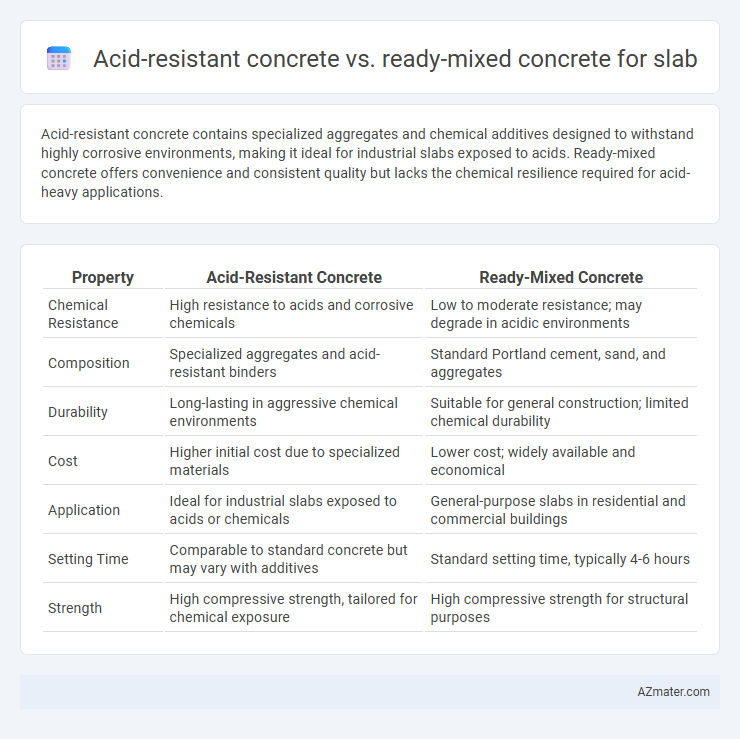Acid-resistant concrete contains specialized aggregates and chemical additives designed to withstand highly corrosive environments, making it ideal for industrial slabs exposed to acids. Ready-mixed concrete offers convenience and consistent quality but lacks the chemical resilience required for acid-heavy applications.
Table of Comparison
| Property | Acid-Resistant Concrete | Ready-Mixed Concrete |
|---|---|---|
| Chemical Resistance | High resistance to acids and corrosive chemicals | Low to moderate resistance; may degrade in acidic environments |
| Composition | Specialized aggregates and acid-resistant binders | Standard Portland cement, sand, and aggregates |
| Durability | Long-lasting in aggressive chemical environments | Suitable for general construction; limited chemical durability |
| Cost | Higher initial cost due to specialized materials | Lower cost; widely available and economical |
| Application | Ideal for industrial slabs exposed to acids or chemicals | General-purpose slabs in residential and commercial buildings |
| Setting Time | Comparable to standard concrete but may vary with additives | Standard setting time, typically 4-6 hours |
| Strength | High compressive strength, tailored for chemical exposure | High compressive strength for structural purposes |
Introduction to Concrete Types for Slab Construction
Acid-resistant concrete is specifically formulated with high-quality aggregates and chemical-resistant additives to withstand corrosive environments, making it ideal for industrial slab applications exposed to acids. Ready-mixed concrete offers convenience and consistent quality, produced in controlled batching plants and delivered directly to construction sites for immediate use in general slab construction. Choosing between acid-resistant and ready-mixed concrete depends on the slab's exposure conditions, required durability, and chemical resistance needs.
What is Acid-Resistant Concrete?
Acid-resistant concrete is specially formulated to withstand corrosive environments by incorporating chemical-resistant aggregates and binders, making it ideal for industrial slabs exposed to acids and harsh chemicals. Unlike ready-mixed concrete, which is standard and designed for general applications, acid-resistant concrete provides enhanced durability and longevity in acidic conditions, reducing maintenance costs and structural degradation. This type of concrete ensures superior protection in facilities like chemical plants, sewage treatment, and food processing industries where acid exposure is prevalent.
Understanding Ready-Mixed Concrete
Ready-mixed concrete offers consistent quality and controlled composition, making it ideal for slabs requiring uniform strength and durability. Unlike acid-resistant concrete, which is specially formulated with chemical admixtures and aggregates to withstand corrosive environments, ready-mixed concrete prioritizes ease of use and versatility in general construction. Its precise batching and timely delivery reduce on-site labor and minimize material waste, ensuring optimal slab performance under standard conditions.
Key Differences Between Acid-Resistant and Ready-Mixed Concrete
Acid-resistant concrete is specifically formulated with chemical-resistant aggregates and additives to withstand corrosive environments, making it ideal for industrial slabs exposed to acids and harsh chemicals. Ready-mixed concrete, in contrast, is a general-purpose mix produced off-site and designed for routine structural applications without enhanced chemical resistance. Key differences include the specialized composition and durability of acid-resistant concrete versus the convenience and versatility of ready-mixed concrete for standard slab construction.
Chemical Resistance: Performance in Harsh Environments
Acid-resistant concrete offers superior chemical resistance compared to ready-mixed concrete, making it ideal for slabs exposed to harsh environments with strong acids and corrosive chemicals. Its formulation includes specialized aggregates and resin binders that prevent degradation, ensuring long-term durability and structural integrity in industrial settings. Ready-mixed concrete lacks this enhanced chemical protection, leading to faster deterioration and potential safety hazards when used in acid-prone applications.
Structural Durability and Lifespan Comparison
Acid-resistant concrete incorporates specialized aggregates and chemical admixtures to withstand corrosive environments, enhancing structural durability against chemical attacks, especially in industrial flooring slabs. Ready-mixed concrete offers versatility and consistent quality but lacks inherent chemical resistance, making it less suitable for harsh acidic conditions without additional protective coatings. The lifespan of acid-resistant concrete slabs typically exceeds that of standard ready-mixed concrete slabs by several years when exposed to aggressive substances, ensuring longer-term performance and reduced maintenance costs.
Application Scenarios: Where Each Concrete Type Excels
Acid-resistant concrete excels in industrial environments exposed to strong acids, such as chemical plants, wastewater treatment facilities, and laboratories, providing durability against aggressive chemical attacks. Ready-mixed concrete is ideal for general construction projects like residential slabs, commercial buildings, and infrastructure where standard compressive strength and workability are required without specialized chemical resistance. Selecting between these concretes depends on the exposure conditions: acid-resistant concrete ensures longevity in corrosive settings, while ready-mixed offers cost-effective, efficient solutions for typical structural applications.
Cost Analysis: Acid-Resistant vs Ready-Mixed Concrete
Acid-resistant concrete typically incurs higher initial costs due to the use of specialized materials like silica fume, quartz, and chemical additives that enhance durability against corrosive environments. Ready-mixed concrete offers a more economical option with standardized production processes and bulk manufacturing, reducing per-unit costs for slab applications. Over time, acid-resistant concrete may lower maintenance expenses and extend lifespan in aggressive settings, potentially balancing the upfront cost differential compared to ready-mixed concrete.
Installation Techniques and Best Practices
Acid-resistant concrete requires specialized installation techniques involving thorough surface preparation, precise mixing ratios, and controlled curing processes to ensure chemical durability for slab applications. Ready-mixed concrete offers faster placement with consistent quality, relying on proper batching, transport, and timely pouring to prevent segregation and ensure slab uniformity. Best practices include using acid-resistant aggregates and additives for acid-resistant slabs, while ready-mixed slabs benefit from proper consolidation and curing to enhance strength and durability.
Choosing the Right Concrete for Slab: Decision Factors
Acid-resistant concrete offers superior durability and chemical resistance ideal for industrial slabs exposed to harsh acidic environments, whereas ready-mixed concrete provides convenience and consistent quality for general slab applications. Key decision factors include the chemical exposure level, mechanical stress, environmental conditions, and budget constraints. Selecting acid-resistant concrete optimizes longevity in corrosive settings, while ready-mixed concrete balances cost and performance for standard construction projects.

Infographic: Acid-resistant concrete vs Ready-mixed concrete for Slab
 azmater.com
azmater.com